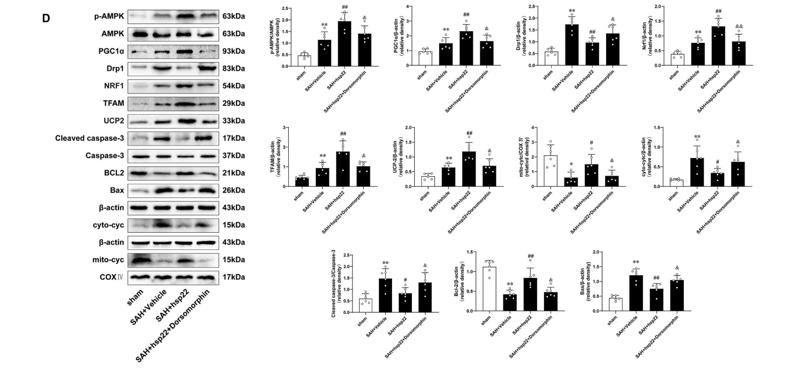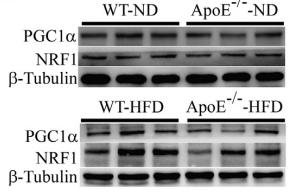NRF1 Antibody - #AF5298
| Product: | NRF1 Antibody |
| Catalog: | AF5298 |
| Description: | Rabbit polyclonal antibody to NRF1 |
| Application: | WB IF/ICC |
| Reactivity: | Human, Mouse, Rat |
| Prediction: | Pig, Zebrafish, Bovine, Horse, Sheep, Rabbit, Dog, Xenopus |
| Mol.Wt.: | 55kD, 70kD; 54kD(Calculated). |
| Uniprot: | Q16656 |
| RRID: | AB_2837783 |
Related Downloads
Protocols
Product Info
*The optimal dilutions should be determined by the end user.
*Tips:
WB: For western blot detection of denatured protein samples. IHC: For immunohistochemical detection of paraffin sections (IHC-p) or frozen sections (IHC-f) of tissue samples. IF/ICC: For immunofluorescence detection of cell samples. ELISA(peptide): For ELISA detection of antigenic peptide.
Cite Format: Affinity Biosciences Cat# AF5298, RRID:AB_2837783.
Fold/Unfold
alpha pal; alpha palindromic binding protein; Alpha palindromic-binding protein; Alpha-pal; locus control region factor 1; NFE2 related factor 1; NRF-1; Nrf1; NRF1_HUMAN; Nuclear respiratory factor 1;
Immunogens
- Q16656 NRF1_HUMAN:
- Protein BLAST With
- NCBI/
- ExPASy/
- Uniprot
MEEHGVTQTEHMATIEAHAVAQQVQQVHVATYTEHSMLSADEDSPSSPEDTSYDDSDILNSTAADEVTAHLAAAGPVGMAAAAAVATGKKRKRPHVFESNPSIRKRQQTRLLRKLRATLDEYTTRVGQQAIVLCISPSKPNPVFKVFGAAPLENVVRKYKSMILEDLESALAEHAPAPQEVNSELPPLTIDGIPVSVDKMTQAQLRAFIPEMLKYSTGRGKPGWGKESCKPIWWPEDIPWANVRSDVRTEEQKQRVSWTQALRTIVKNCYKQHGREDLLYAFEDQQTQTQATATHSIAHLVPSQTVVQTFSNPDGTVSLIQVGTGATVATLADASELPTTVTVAQVNYSAVADGEVEQNWATLQGGEMTIQTTQASEATQAVASLAEAAVAASQEMQQGATVTMALNSEAAAHAVATLAEATLQGGGQIVLSGETAAAVGALTGVQDANGLVQIPVSMYQTVVTSLAQGNGPVQVAMAPVTTRISDSAVTMDGQAVEVVTLEQ
Predictions
Score>80(red) has high confidence and is suggested to be used for WB detection. *The prediction model is mainly based on the alignment of immunogen sequences, the results are for reference only, not as the basis of quality assurance.
High(score>80) Medium(80>score>50) Low(score<50) No confidence
PTMs - Q16656 As Substrate
| Site | PTM Type | Enzyme | Source |
|---|---|---|---|
| S39 | Phosphorylation | Uniprot | |
| S44 | Phosphorylation | Uniprot | |
| S46 | Phosphorylation | Uniprot | |
| S47 | Phosphorylation | Uniprot | |
| S52 | Phosphorylation | Uniprot | |
| T87 | Phosphorylation | Uniprot | |
| K92 | Ubiquitination | Uniprot | |
| S99 | Phosphorylation | Uniprot | |
| T109 | Phosphorylation | Uniprot | |
| T118 | Phosphorylation | Uniprot | |
| Y122 | Phosphorylation | Uniprot | |
| T123 | Phosphorylation | Uniprot | |
| S136 | Phosphorylation | Uniprot | |
| S138 | Phosphorylation | Uniprot | |
| K139 | Ubiquitination | Uniprot | |
| K214 | Ubiquitination | Uniprot | |
| K221 | Acetylation | Uniprot | |
| K226 | Acetylation | Uniprot | |
| T259 | Phosphorylation | Uniprot | |
| K267 | Ubiquitination | Uniprot |
Research Backgrounds
Transcription factor that activates the expression of the EIF2S1 (EIF2-alpha) gene. Links the transcriptional modulation of key metabolic genes to cellular growth and development. Implicated in the control of nuclear genes required for respiration, heme biosynthesis, and mitochondrial DNA transcription and replication.
Phosphorylation enhances DNA binding.
Nucleus.
Ubiquitously expressed with strongest expression in skeletal muscle.
Homodimer. Binds DNA as a dimer. Interacts with PPRC1.
Belongs to the NRF1/Ewg family.
Research Fields
· Environmental Information Processing > Signal transduction > Apelin signaling pathway. (View pathway)
· Human Diseases > Neurodegenerative diseases > Huntington's disease.
References
Application: WB Species: rat Sample: brain
Application: WB Species: mouse Sample: liver
Application: WB Species: Rat Sample: intermuscular adipose tissues (IMATs)
Restrictive clause
Affinity Biosciences tests all products strictly. Citations are provided as a resource for additional applications that have not been validated by Affinity Biosciences. Please choose the appropriate format for each application and consult Materials and Methods sections for additional details about the use of any product in these publications.
For Research Use Only.
Not for use in diagnostic or therapeutic procedures. Not for resale. Not for distribution without written consent. Affinity Biosciences will not be held responsible for patent infringement or other violations that may occur with the use of our products. Affinity Biosciences, Affinity Biosciences Logo and all other trademarks are the property of Affinity Biosciences LTD.



